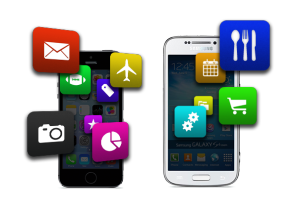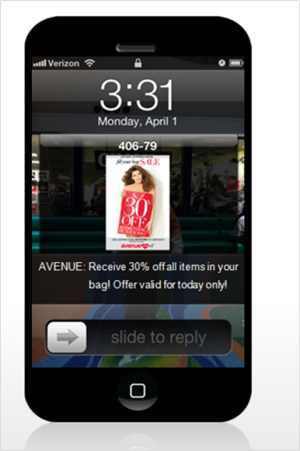Push Mobile Marketing — App Notifications Vs. Messaging
Every day, marketers are finding new and innovative strategies to reach their target audience and build loyal relationships. Luckily, through mobile, we have a channel that allows us to get even more up close and personal with consumers. To have a balanced mobile strategy, it is important to leverage both push and pull techniques. We […]
Every day, marketers are finding new and innovative strategies to reach their target audience and build loyal relationships. Luckily, through mobile, we have a channel that allows us to get even more up close and personal with consumers. To have a balanced mobile strategy, it is important to leverage both push and pull techniques.
We are all very familiar with pull mobile techniques like responsive mobile sites and mobile applications where customers proactively attain the goods or information they need. In this article, we will delve into some of the more innovative push marketing techniques and explain in detail the differences between mobile app notifications and mobile messaging.
Push Notifications Via Mobile Apps

Iris Mobile’s – Mobile Apps
Mobile applications have become an essential part of mobile marketing. Through apps, you can deliver rich and contextual content to any customer who downloads the experience and develop a more personal relationship with your customer based on usage insights.
Getting your users to successfully download your app is the first step in establishing this relationship; but, it is not enough to ensure consistent usage. The conversation must be maintained so that the app and the brand continue to serve as important elements in the consumers’ daily lives. That’s where a push mobile marketing strategy comes in.
With a push mobile marketing strategy, brands initiate and maintain the conversation with consumers so they will be motivated to continually engage with the brand.
App alerts are a great way for brands to inform consumers of any new app updates or features, but they can also be used to notify users of promotions or in-store activities. The key benefit they provide is a sense of urgency to open the app once users receive a push notification. In fact, research by startup Urban Airship shows daily app usage increasing by up to 540 percent with push notifications.
For an example of a company using app alerts effectively, just look at flash-sale site, Rue La La. In April of 2012, Rue La La’s mobile commerce sales exceeded ecommerce sales one day, due in part to the strategic use of push notifications. The boost in mobile sales with Rue La La could be attributed to the fact that they were efficient at alerting their customers to upcoming sales. The app also has the added value of allowing users to customize their alerts so that they receive notifications for specific brands that go on sale.
While app alerts are a valuable way to communicate to consumers, it’s critical to remember that all push notifications can be turned off. Most consumers have dozens of apps on their smartphones, so it is not uncommon that they would disable one or two push notifications to avoid being inundated with annoying alerts. In addition, not all notifications are created equal. Depending on the smartphone, push notification settings could potentially be disabled as a default, which would inhibit your messaging from reaching your consumers unless they enable this feature themselves.
Mobile Messaging

Iris Mobile’s – Mobile Messaging
It’s no secret that messaging is a direct path to your customers and should be an essential part of most mobile strategies. As a beneficial tool to connect one-on-one with your customers, mobile messaging provides you with a simple way to send relevant content at the discretion of the brand, similar to the way email drives users to digital experiences.
Messaging is a fast and effective way to disseminate real-time information such as offers, promotions or other branded content to your customers with high delivery rates. In fact, 90% of text messages are read within 3 minutes of delivery.
A number of brands have experienced great success through the use of mobile messaging. With a mobile messaging strategy, Avenue, a fashion retailer for real-sized women, was able to achieve an ROI of over 6,600%, as well as drive in-store traffic and increase sales.
The campaign consisted of weekly promotions that effectively motivated subscribers to visit the store for the latest fashions. Avenue was able to accomplish these results through rich media messaging. With this innovative technology, subscribers were sent image-based coupons with an effective call to action that produced high engagement rates.
The barriers to entry for customers to engage in a mobile messaging program are much lower than getting mobile application participation. To begin the messaging relationship, you must first get customers to opt-in to your campaign, but there is one significant difference — mobile messaging works on every platform and almost every mobile device on the market.
Once this initial interaction takes place, the brand is free to send relevant content as needed. Because messaging is such a personal channel, it should be used sparingly and focus on personalized value-based content if possible to achieve the best results. This will ensure your customers are engaged and appreciate the content you are sending via messaging.
All messaging tactics are not created equal. SMS is a great way to send a very simple message with a maximum of 160 characters, but can be limiting for brands. With the innovation of image and video-based messaging techniques like Rich Media Messaging, marketers are experiencing even better results due to the natural customer reaction to image-based campaigns. Intelligent handset detection can also be used as part of your messaging campaign to drive users with smartphones to your other mobile initiatives like mobile applications.
Whether your mobile strategy calls for app push notifications or mobile messaging, it is critical to understand your customers’ needs, habits and engagement levels to create a sustainable mobile relationship. Above all, you should remember the key to success — don’t be annoying and use each push strategy sparingly with value-based content to get the best results over time.
With any mobile strategy, it is important to determine the optimal frequency of messages and alerts to ensure that consumers are not being sent an overwhelming amount of messages and are responding in a positive way to your campaign. For any mobile strategy you choose, the perfect balance should consist of important and relevant content as well as impeccable timing.
Opinions expressed in this article are those of the guest author and not necessarily MarTech. Staff authors are listed here.
Related stories